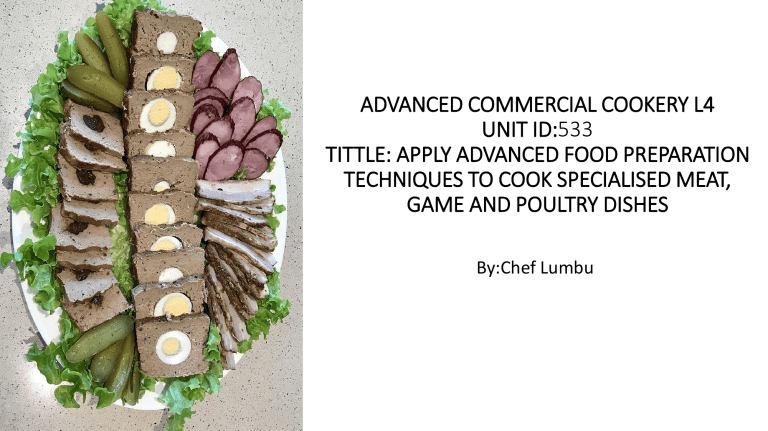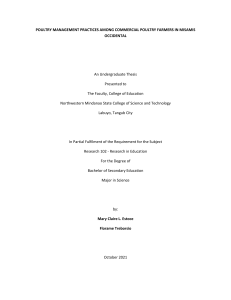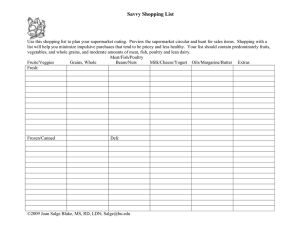
ADVANCED COMMERCIAL COOKERY L4 UNIT ID:533 TITTLE: APPLY ADVANCED FOOD PREPARATION TECHNIQUES TO COOK SPECIALISED MEAT, GAME AND POULTRY DISHES By:Chef Lumbu Lesson ObJECTIVES By the end of this unit will students will be able: • to demonstrate competency in preparing, cooking and finishing meat and poultry and meat and poultry dishes. Prepare meat Types and cuts of meat: • Lamb e.g., leg, offal, loin, fillet, saddle, noisettes, rack, shoulder, shank, cutlets, chops; • Beef e.g. shin, oxtail, rump, sirloin, fillet, 5-bone rib, rib eye, brisket, topside, silverside, steaks, burgers, offal; • Veal e.g., loin, escalope, offal; • Pork e.g., loin, fillet, medallions, escalope, chops, belly, rib, shoulder, leg, bacon e.g., rashers, back, streaky, hock, collar, gammon joint, gammon steak •Quality points in ingredients: fresh smell, fresh looking colour, undamaged packaging •Tools and equipment: knives, colour coded chopping boards, bowls •Preparation: skinning, scoring, boning, trimming, slicing, dicing, mincing, stuffing, tying and securing, application of coatings, application of flavourings •Storing: appropriate temperatures, separating raw foods and ready to eat foods Cook meat • Tools and equipment: grills, shallow fryers, ovens, pans, knives, color coded chopping boards, mincers, protective gloves • Cooking methods: grilling, barbequing, shallow frying, pan frying, roasting, stir frying, boiling, braising, pot roasting, seasoning, tasting, timing, • Dish quality: color, texture, appearance, aroma, taste, consistency, quantity, temperature • Holding temperature: above 63ᵒC • Safe storage: cooling quickly; blast chilling from 63˚C to 5˚C; storing in shallow airtight containers below 5˚C Prepare poultry • Types of poultry: turkey, chicken including baby chicken, roasting chicken, boiling fowl, capon, duck, goose, Guinea fowl • Quality points in ingredients: fresh smell, fresh looking color, undamaged packaging • Tools and equipment: knives, color coded chopping boards, bowls • Preparation: weighing and portioning, trussing, boning, skinning, cutting, removing sinew, seasoning application of coatings, application of flavorings • Storing: appropriate temperatures, separating raw foods and ready to eat foods COOK POULTRY • Tools and equipment: grills, shallow fryers, ovens, pans, knives, color coded chopping boards, mincers, protective gloves • Cooking methods: grilling, barbequing, shallow frying, pan frying, roasting, stir frying, boiling, braising, pot roasting, seasoning, tasting, timing • Dish quality: color, texture, appearance, aroma, taste, consistency, quantity, temperature • Holding temperature: above 63ᵒC • Safe storage: cooling quickly; blast chilling from 63˚C to 5˚C; storing in shallow airtight containers below 5˚C PLATE, PRESENT AND GARNISH MEAT AND POULTRY DISHES • Plating: size, colour, shapes, style, portion size, balance, placement, precision • Presentation: style, flair, modern, traditional, experimental • Garnish: herbs and leaves, edible flowers, fruits and vegetables, purees, sauces and syrups WORK AS AN EFFECTIVE MEMBER OF THE TEAM Communication: i. spoken e.g., tone of voice, terminology ii. written e.g., documents, forms, reports, presentations iii. body language e.g., posture • Situations: formal, informal, queries or requests, complaints • Codes of conduct: workplace policies, rules and procedures • Reporting: supervisor, line manager, challenges, issues, queries FOLLOW HEALTH AND SAFETY PROCEDURES • Common workplace hazards: slips, trips, falls, breakages, hot surfaces, chemicals • Health and safety procedures: following fire regulations, fire drills, evacuation, manual handling, safe use of chemicals, report accidents, first aid • Workplace emergencies: accidents, fire, breaches of security, illness • Emergency procedures: raising alarm, calling emergency services, firefighting equipment, evacuation procedures • Security procedures: control of keys, electronic systems, surveillance, control of entrances and exits, staff and visitor identity badge, reporting of suspicious persons and packages to line manager FOLLOW HYGIENE PROCEDURES • Personal hygiene: • clean clothing, footwear and headgear • hair neat and tidy • wear a head covering e.g., hairnet, hat • washing hands • no jewellery • cover cuts and grazes • report illness and infections to the proper person •Cleanliness of work areas: clean cloths for wiping and cleaning between tasks, equipment used for preparing, displaying and serving food are clean and in good condition, waste disposed of promptly, hygienically and appropriately, use of correct cleaning chemicals •Handling and storing food: covering food, separation of raw and cooked food, contact surfaces and equipment •Storage temperatures e.g., fridge, freezer •Food labelling and dates •Food temperatures e.g., cooking, serving re-heating •Cleaning and washing-up procedures •Handling of food waste


